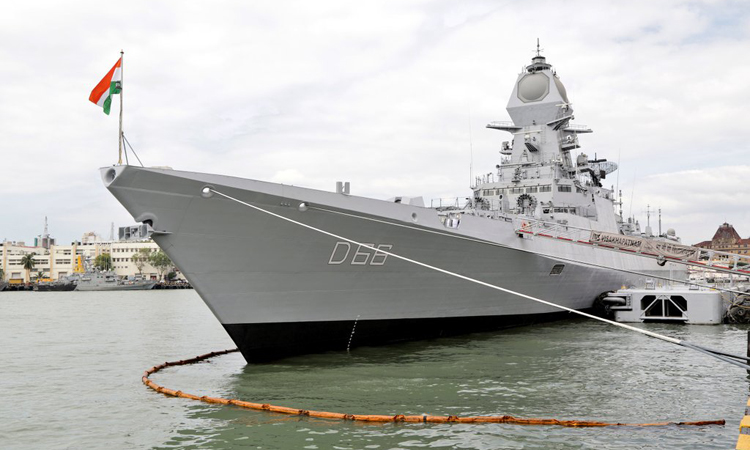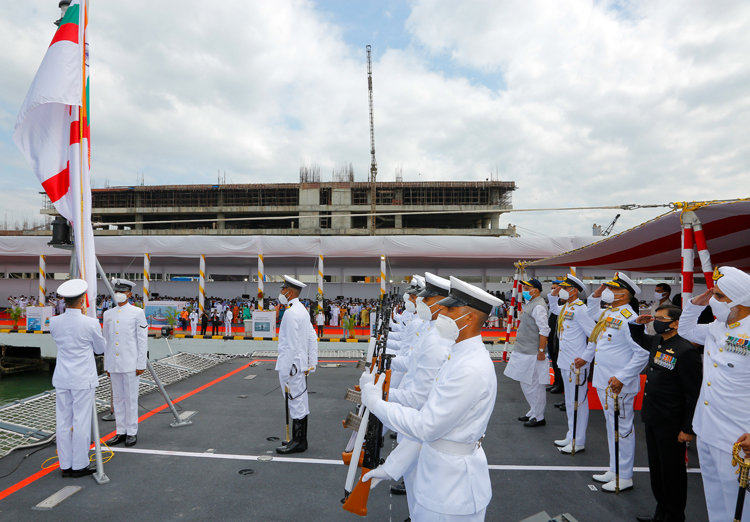INDIAN ARMED FORCES CHIEFS ON OUR RELENTLESS AND FOCUSED PUBLISHING EFFORTS

The insightful articles, inspiring narrations and analytical perspectives presented by the Editorial Team, establish an alluring connect with the reader. My compliments and best wishes to SP Guide Publications.

"Over the past 60 years, the growth of SP Guide Publications has mirrored the rising stature of Indian Navy. Its well-researched and informative magazines on Defence and Aerospace sector have served to shape an educated opinion of our military personnel, policy makers and the public alike. I wish SP's Publication team continued success, fair winds and following seas in all future endeavour!"

Since, its inception in 1964, SP Guide Publications has consistently demonstrated commitment to high-quality journalism in the aerospace and defence sectors, earning a well-deserved reputation as Asia's largest media house in this domain. I wish SP Guide Publications continued success in its pursuit of excellence.
- MoD initiates comprehensive review of Defence Acquisition Procedure 2020, pushes for defence reforms
- G7: The Swansong
- Kalinga Connect: South Asia to Polynesia
- Advanced MRSAM for India for a greater firepower
- Must Credit DRDO for Operation Sindoor, now what is next for defence R&D?
- Operation Sindoor | Day 2 DGMOs Briefing
- Operation Sindoor: Resolute yet Restrained
Subtle message to China – INS Visakhapatnam
With the changing power dynamics in the Indian Ocean Region, INS Visakhapatnam will augment the Indian Navy’s mobility, reach and flexibility towards accomplishment of its tasks and goals

With newly acquired muscle power, India conveyed a subtle message to China on its resolve to keep Indo-Pacific open and free, which includes South China Sea, majority area of which is claimed by China as its maritime territory. With China’s new maritime law promulgated recently, advising foreign ships passing through the area to declare its destinations and contents, India along with its other Indo-Pacific partners need warships like INS Visakhapatnam to counter the expansionist designs of China. While commissioning India’s one of the most powerful ships on November 21, 2021 at Naval Dockyard Mumbai, Defence Minister Rajnath Singh described the missile destroyer as a symbol of growing maritime prowess of the country. He referred to the warship as a reminder of ancient and medieval India’s maritime power, ship-building skills and glorious history. Undoubtedly, the latest warship in India’s ever growing fleet with its range of surface and aerial weapons and sensors, will dominate several hundred square kilometres of the maritime area wherever it is deployed.
Because of enemy-shivering fire power, the world community, especially in China, will be forced to take note of its induction in Indian Navy
Today is a proud day for India’s quest to become Aatmanirbhar in the defence sector. INS Visakhapatnam is commissioned into Indian Navy! It is indigenously developed and will strengthen our security apparatus. Our efforts towards defence modernisation continues with full vigour. pic.twitter.com/LwVIX3ufzq
— Narendra Modi (@narendramodi) November 21, 2021
Christened as P15B stealth guided missile destroyer , INS Visakhapatnam, is the first of the four stealth guided warships to be constructed in Naval Dockyard Mumbai which will be armed with ferocious supersonic surface-to-surface‘Made in India’, Brahmos missiles and Barak-8 long range surface-to-air missiles, acquired from Israel.The warships undersea warfare capability has been made formidable with indigenously made anti-submarine weapons and sensors like the Hull mounted Sonar HUMSA NG, heavyweight torpedo tube launchers and rocket launchers. Because of these enemy-shivering fire power, the world strategic community, especially in China, will be forced to take note of its induction in Indian Navy. With the changing power dynamics in the Indian Ocean Region, INS Visakhapatnam will augment the Indian Navy’s mobility, reach and flexibility towards accomplishment of its tasks and goals.
Indian Naval Chief Admiral Karambir Singh described the commissioning as a major milestone in indigenous shipbuilding, capability, fire power and intent in securing the Indian Ocean region
Attended the commissioning ceremony of INS Visakhapatnam into Indian Navy today. This indigenously developed missile destroyer is packed with state-of-the-art weapons & modern technology. It is a symbol of India’s growing maritime prowess.@indiannavy https://t.co/kpQCUHiGy8 pic.twitter.com/7G35fFlzQ1
— Rajnath Singh (@rajnathsingh) November 21, 2021
Without naming China, Defence Minister Rajnath Singh reminded India’s northern belligerent neighbour that India, as a responsible maritime stakeholder, is a supporter of consensus-based principles and a peaceful, open, rule-based and stable maritime order. “In the 'United Nations Convention on the Laws of the Sea' (UNCLOS) of 1982, territorial waters of nations, exclusive economic zones and the principle of 'Good order at sea' have been propounded. Some irresponsible nations, for the sake of their narrow partisan interests, keep on giving new and inappropriate interpretations to these international laws from hegemonic tendencies. The arbitrary interpretations create obstacles in the path of a rule-based maritime order. We envision a rules-based Indo-Pacific, with freedom of navigation, free trade and universal values, in which the interests of all the participating countries are protected,” he said.

Making an indirect dig at China, Rajnath Singh also referred to Prime Minister Narendra Modi’s vision of SAGAR (Security and Growth for All in the Region) which Indian Navy is taking forward with the spirit of friendship, openness, dialogue and co-existence with the neighbours.
?? ?? ?? ?? ??? ???? ?? ??? ?? ?? ????? Navy ?????? order ??? ?? 41 ships ?? submarines ??? ?? 39 Indian shipyards ?? ???I ?? Navy ?? '?????????? ????' ?? ????? commitment ?? ?????? ??: ????? ??????
— ????? ?????? ????????/ RMO India (@DefenceMinIndia) November 21, 2021
Indian Naval Chief Admiral Karambir Singh described the commissioning as a major milestone in indigenous shipbuilding, capability, fire power and intent in securing the Indian Ocean region. Indian Navy is the primary manifestation of India’s maritime power. He said that of the 41 ships in order, 39 are being constructed in India, which is an example of Atmanirbharta i.e. self-dependence. The ship can rightfully be described as one of the most potent warships, which has the capability of embarking two integrated helicopters to further extend her reach.
A unique feature of this ship is the high level of indigenisation incorporated in the production, accentuating the national objective of ‘Atmanirbhar Bharat’
According to an official description of the warship features,its length measures 163 metres and breadth 17 metres with a displacement of 7400 tonnes. A unique feature of this ship is the high level of indigenisation incorporated in the production, accentuating the national objective of ‘Atmanirbhar Bharat’(self-dependent India). Some of the major indigenised equipment/system onboard INS Visakhapatnam include Combat Management System, Rocket Launcher, Torpedo Tube Launcher, Integrated Platform Management System, Automated Power Management System, Foldable Hangar Doors, Helo Traversing system, Close-in Weapon System and the Bow mounted SONAR. Significantly Visakhapatnam has been constructed using indigenous steel DMR 249 A and is amongst the largest destroyers constructed in India. Named after the historic city of Andhra Pradesh on the east coast, Visakhapatnam, the ‘City of Destiny’, the ship has a total complement of about 315 personnel. Enhanced crew comfort is a significant feature of INS Visakhapatnam, which has been ensured through ergonomically designed accommodation based on ‘modular’ concepts. The ship will be under the command of Captain Birendra Singh Bains, a Navigation & Direction specialist.
Coming days will see more of such potent warships made in India like the Commissioning of INS Vela , the fourth submarine of Project -75 and launch of first Survey Vessel large project , Sandhayak in early December.





